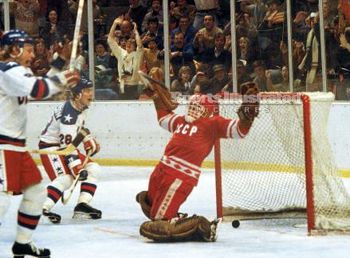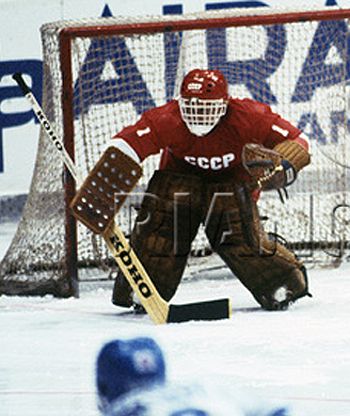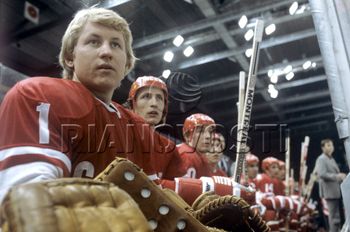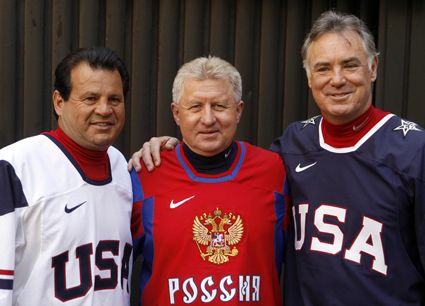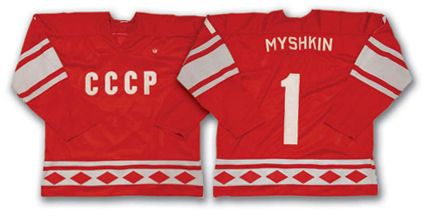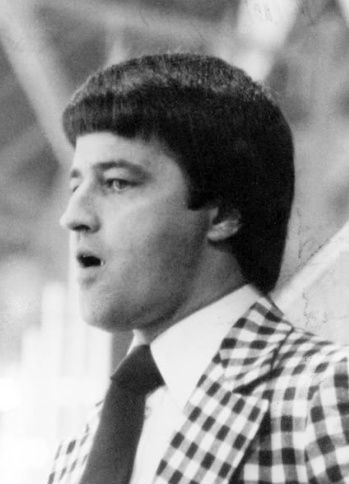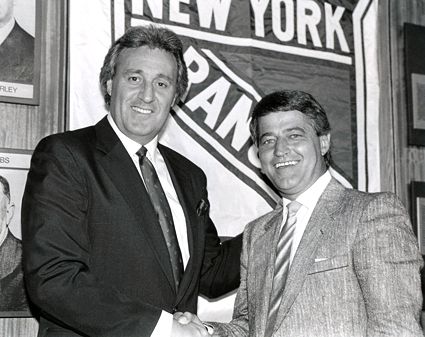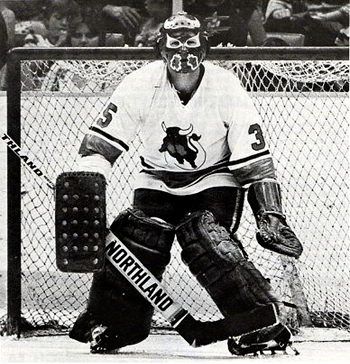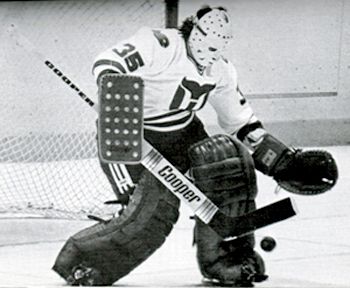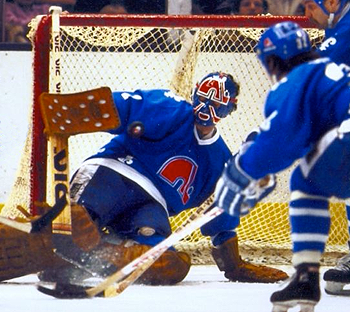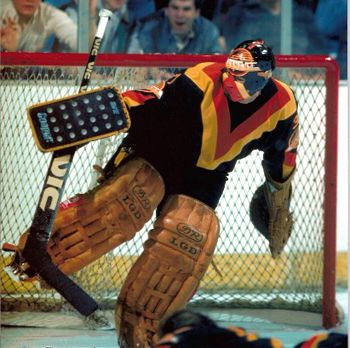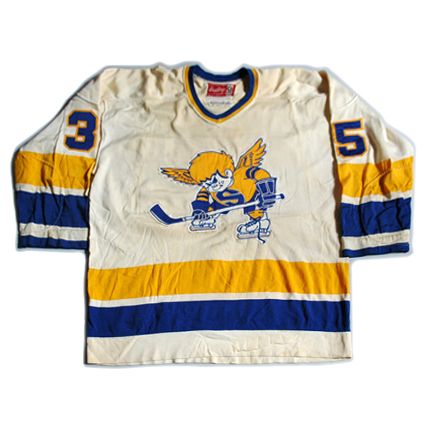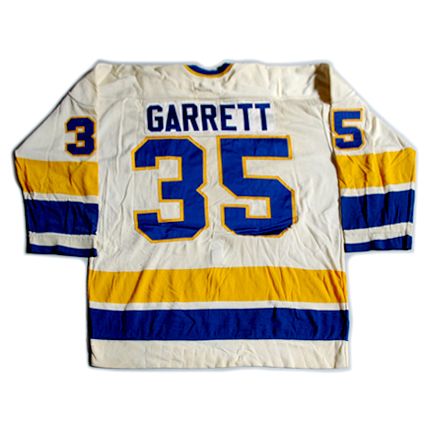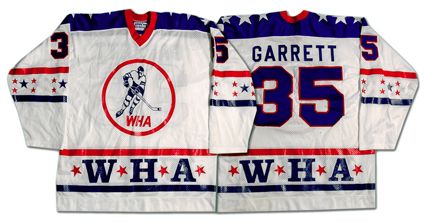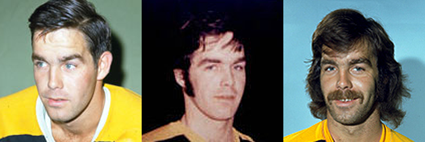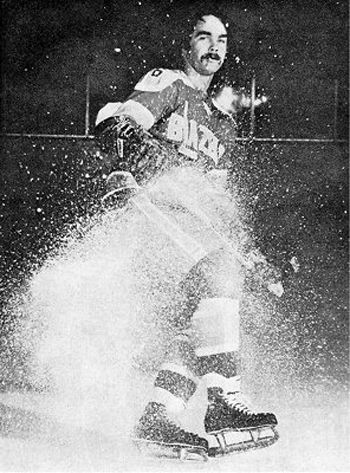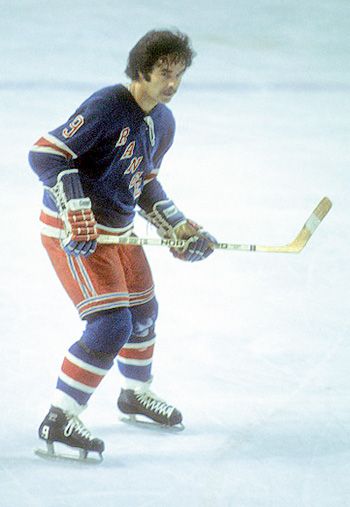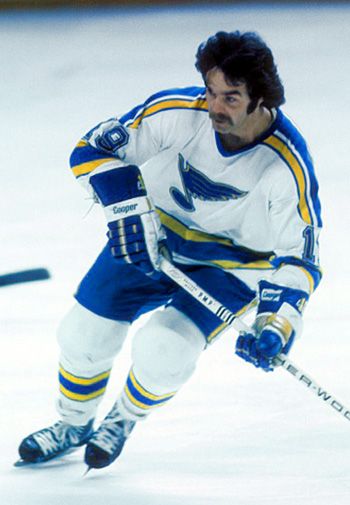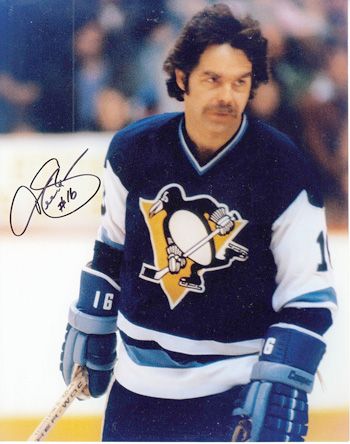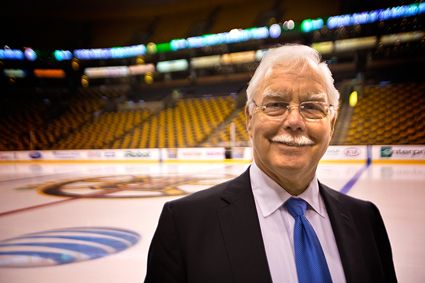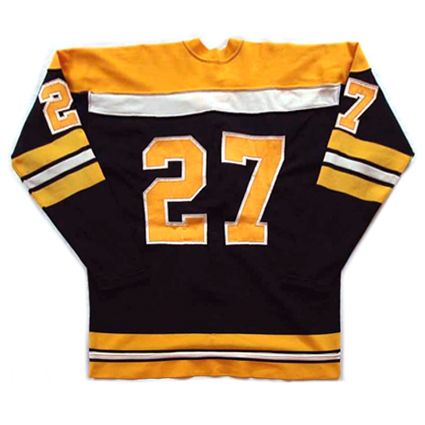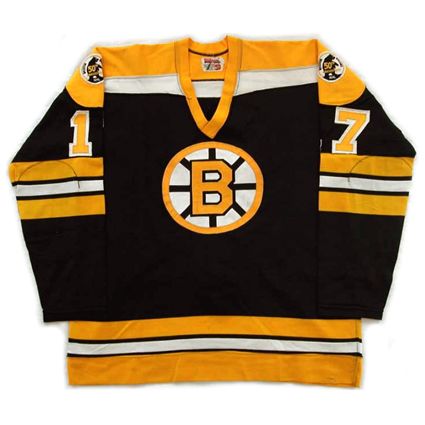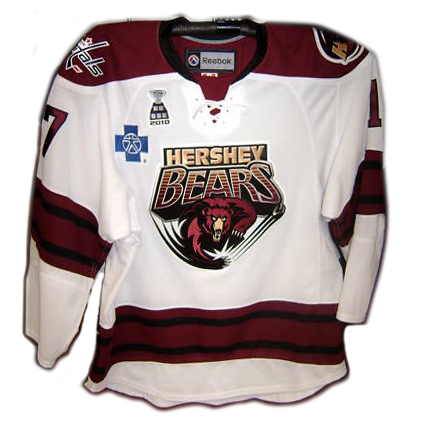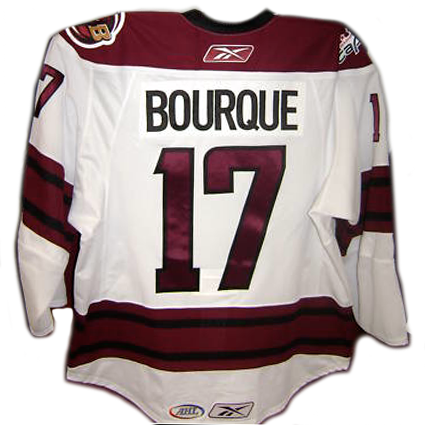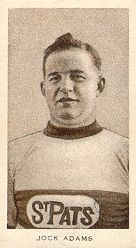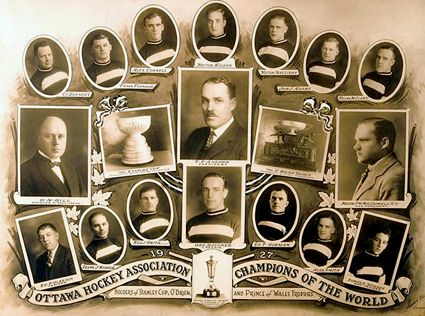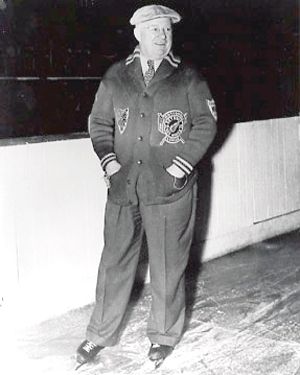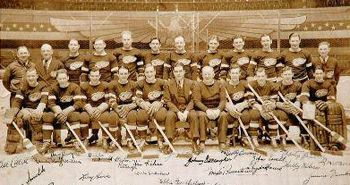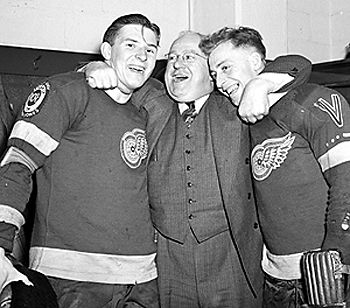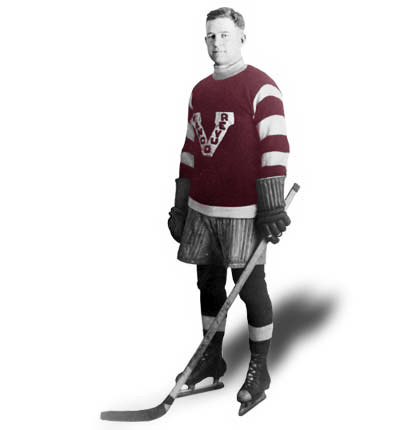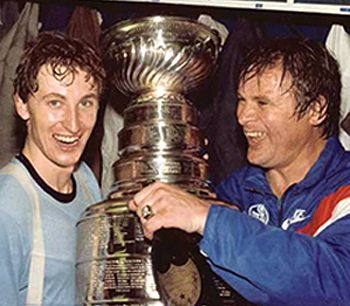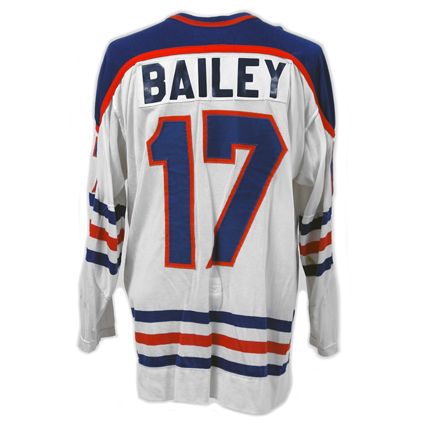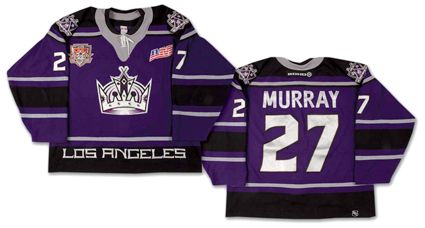Saturday, June 19, 2010
1981 Soviet Union National Team Vladimir Myshkin Jersey
Born on this date in 1955, Vladimir Myshkin is best remembered for being the goaltender who gave up Mike Eruzione's game winning goal in the 1980 Olympic "Miracle on Ice" game versus the United States, but there was certainly more to the man that just that single goal against.
Myshkin reacts to Eruzione's goal in 1980
He began his career with Krylia Sovetov (Soviet Wings), the club sponsored by the Soviet Air Force, where he played in both the 1977-78 and 1978-79 seasons. Following the 1979 season, he made his World Championship debut with the Soviet Union in 1979, playing in two games on the gold medal winning team.
For the 1979-80 season, Myshkin would move to the KGB's Dynamo Moscow club, where he would remain for the next 11 seasons as their undisputed number one, averaging nearly 40 games a season in a league with a schedule of between 40 and 50 games a year.
Myshkin in goal for Dynamo
Unfortunately for Myshkin, his career at Dynamo coincided with the rival Red Army (also known as CSKA Moscow) club's most dominant period in their history, reeling off 13 consecutive Soviet League titles from 1977 to 1989. Finally, in Myshkin's final season with the club, payoff arrived as Dynamo Moscow was finally able to wrest the title away from Red Army in 1990.
Following the long sought after Soviet League championship, Myshkin would play one final professional season with Lukko Rauma in Finland's SM-Liiga as their number one goalie.
Internationally, Myshkin was a regular member of the Soviet National Team, but like his timing playing for Dynamo during the era of Red Army, Myshkin's career as a goaltender unfortunately coincided with that of the legendary Vladislav Tretiak, recognized world-wide as one of, if not the, top goaltender in the world. The result for Myshkin was a trophy case full of medals and little playing time.
He was a member of the gold medal winning World Championship team in 1979 (2 games played), 1981 (1), 1982 (3) and 1983 (3). Finally after the retirement of Tretiak in 1984, Myshkin was given the reins in 1985 and played in ten games only to see the Soviet Union knocked off their perch and finish third after losing to both Czechoslovakia and Canada in the Final Round.
And with that, Myshkin once more returned to his familiar role as backup on the National Team, as in the 1989, 1990 and 1991 World Championships, he would play but one game in each tournament, yet come home with gold medals in both 1989 and 1990.
The story was very much the same in the 1981 Canada Cup with one start in seven games but another gold medal to bring home in his luggage.
Myshkin at the 1982 Izvestia Cup
Thing would change in the 1984 edition of the Canada Cup with Tretiak now out of the picture following his retirement after winning a gold medal at the 1984 Olympics, where Myshkin saw action in but a single game once more.
Despite Myshkin's failure to secure the nearly customary gold medal in the 1984 World Championships, he was back in goal at the 1984 Canada Cup. While Myshkin would defeat Czechoslovakia, Sweden and the United States in round robin play, he would once again fall short with the weight of the world on his shoulders as Canada would take the Soviets to overtime in their semifinal match, the first overtime game in Soviet National Team history, only to have Mike Bossy deflect a puck past Myshkin, who was without his stick after Bossy had collided with him several seconds earlier, to eliminate the Soviets from the competition but Myshkin was named the goaltender on the tournament All-Star Team.
Perhaps the highlight of Myshkin's international career was his 6-0 shutout of the NHL All-Stars at the 1979 Challenge Cup, after the Soviets, with Tretiak in goal, had split Games 1 and 2.
All told, Myshkin would collect six World Championship gold medals, a gold in the Canada Cup and an Olympic gold medal, eight golds in all, and play in a total of just 13 games, perhaps the greatest return on investment in the history of hockey!
Myshkin in his all too familiar spot on the end of the national team bench
Following his playing career, Myshkin would coach the Swiss club HC Davos from 1994 to 1999 and later become the goaltending coach of Dynamo and CSKA Moscow before coaching Vityaz Chekov in Russia.
1980 Olympians Mike Eruzione, Vladimir Myshkin and Jim Craig at a promotional appearance in advance of the 2010 Olympics
Today's featured jersey is a 1981 Soviet National Team Vladimir Myshkin jersey as used in the 1981 Canada Cup tournament.
This style of Soviet jersey with the diamond shapes around the waist was used from the 1976 Canada Cup until 1983, which included the memorable 1980 Olympics.
Our first video today is the game winning goal from the "Miracle on Ice" when Mike Eruzione of the United States gets one past Myshkin in the Soviet goal in place of Tretiak in the third period of their game for the ages.
Here is Canada defeating the Soviet Union in overtime of the 1984 Canada Cup semifinals.
We conclude today with Myshkin's finest game, the third game of the 1979 Challenge Cup, when Myshkin and the Soviets shut out the NHL All-Stars 6-0.
Labels:
Myshkin Vladimir,
Soviet Union
Friday, June 18, 2010
The Coach Who Got Traded
In a most unique transaction on this day back in 1987, the New York Rangers traded their 1988 first round draft pick to the Quebec Nordiques in exchange for the Nordiques' coach Michel Bergeron.
Phil Esposito, the Rangers General Manager at the time, and you just knew during an odd story that somehow Esposito's name would come up at some point, asked the Nordiques about Bergeron almost as a joke during the draft that year and was surprised when the Nordiques GM Maurice Filion said "Let's talk."
Esposito liked Bergeron's combative style, feeling that "motivation and emotion" was what he wanted for the Rangers. Esposito had to take over behind the Rangers bench when Tom Webster was forced to relinquish the job due to an inner-ear problem and brought a fiery style to the bench and he was looking for someone with similar qualities - qualities he found in Bergeron.
Since relations between Bergeron and Filion had become strained, the Nordiques had given Esposito permission to talk to Bergeron, who still had two years remaining on his contract. They spoke for the first time on that Monday and by Wednesday had agreed to a contract and in return, the Rangers sent Quebec it's 1988 first round draft pick and $75,000 cash.
And how did it turn out for Bergeron in New York? He missed the playoffs in his first season with a 36-34-10 record and was fired by Esposito with just two games remaining in his second season with the team at 37-33-8 and replaced by... Esposito himself, who proceeded to lose the last two games of the regular season and then got swept out of the playoffs in four straight by the Pittsburgh Penguins.
Oddly enough, Bergeron would return to coach the Nordiques once more the following season of 1989-90, his last in the NHL. He would finish with a dismal 12-61-7 record.
And what became of the draft pick obtained by the Nordiques for Bergeron? With their second pick in the first round, and the 5th overall, the Nordiques selected Daniel Dore from the Drummondville Voltigeurs of the Quebec Major Junior Hockey League. He totaled 17 NHL games played, 2 goals and 3 assists for 5 career points. To select Dore, the Nordiques passed on Martin Gelinas (1273 GP, 660 pts), Jeremy Roenick (1363 GP, 1216 pts) Rod Brind'Amour (1484 GP, 1184 pts) and Teemu Selanne (1387 GP, 1430 pts), who were picks 7, 8, 9 and 10 that year.
Slam! Sports picked Dore as #8 in their list of Top 10 draft-day busts.
Unfortunately we don't own Bergeron's snazzy plaid sport coat, so no jersey today...
Thursday, June 17, 2010
1973-74 Minnesota Fighting Saints John Garrett Jersey
Perhaps no other players personifies life in the World Hockey Association better than John Garrett. Born on this date and drafted by the St. Louis Blues in the 1971 NHL Entry Draft, Garrett, faced with the prospect of life in the minor leagues riding buses and playing in a dingy old rink for little pay while trying to crack an NHL lineup instead cast his lot with the Minnesota Fighting Saints of the WHA for a higher salary, playing time in a top professional league in a state-of-the-art, brand new arena, featuring cutting edge clear dasherboards! It was a no-brainer for many minor league players in the early 1970's to make the jump to the WHA.
In Minnesota, Garrett split time with former US Olympian Mike Curran, before becoming the number one goalie in 1974-75 with 58 appearances and a 30-23-2 record. The following season Garrett had already played in 52 of the Fighting Saints 59 games, going 26-22-4, when the franchise folded mid-season.
Minnesota Fighting Saint John Garrett - note the clear dasherboards behind him
Garrett's services were then snapped up by the Toronto Toros where their unsettled goaltending situation saw six different men play at least seven games, with none more than 26. While Garrett remained with the franchise for the next two seasons, nothing in the WHA was that simple, as the franchise relocated for the 1976-77 season to the deep south of the United States, finding a new home in Birmingham, Alabama.
Garrett's veteran experience and strong play immediately earned him the starting job and he patrolled the crease for 65 games that season and he was named a First Team WHA All-Star. He also played in 58 games in the 1977-78 season when the "Baby Bulls" were stocked with several players under the age of 20, something never before tried in major professional hockey.
A trade in September saw him dealt to the New England Whalers where he split the goaltending duties with Al Smith for the final season of the WHA. For 1979-80, the Whalers, now renamed the Hartford Whalers, joined the NHL.
During his time in the WHA, Garrett saw and lived through it all. A franchise folding mid-season, a franchise relocation, a trade and eventually a change in leagues!
Garrett led the Whalers in appearances in 1979-80 and 1980-81 with 52 and 54, respectively. With the Whalers failing to qualify for the playoffs in 1981, Garrett was chosen to be a member of Team Canada at the World Championships.
He began the 1981-82 season with Hartford prior to being traded to another WHA refugee club, the Quebec Nordiques in January of 1982 to back up Dan Bouchard.
With Bouchard again getting the majority of the playing time in 1982-83, and the Nordiques wanting to make room for future starter Clint Malarchuk, Garrett was again dealt in February 1983 to the Vancouver Canucks. While he was unable to displace established starter Richard Brodeur, Garrett did play three seasons in Vancouver to close out his NHL career.
Garrett's career concluded with 530 games played, 216 wins, 242 losses and 52 ties between the two leagues combined.
John Garrett's goalie mask history
Today's featured jersey is a 1973-74 Minnesota Fighting Saints John Garrett jersey. The Fighting Saints original jerseys featured the "S" logo and were worn for the first half of their first season before being replaced by the "little saint" logo. None of the original Fighting Saints jerseys survived, as they had their crests removed and were given to Hasting High School to reuse.
Fighting Saints jerseys are some of the most sought after of the WHA game worn jerseys, thanks in part to their classic look, fantastic logo, die-hard fan base and limited availability.
Bonus Jersey: Our bonus jersey is a 1977 WHA All-Star John Garrett jersey as worn in the game in Hartford, Connecticut, won by the East All-Stars 4-2.
Our video section kicks off with a can't miss clip as Fighting Saints coach Harry Neale interviews John Garrett on his arrival with the Fighting Saints. Dig the bow tie and suit!
Next is Part 1 of an interview with Garrett as he looks back on his career and some of the humorous events that happened along the way.
Finally, a look at the Minnesota Fighting Saints 1974-75 season is this classic old film. While you are getting your groove on to the mid-70's soundtrack be sure to note the clear dasherboards used at the old St. Paul Civic Center, home of the Fighting Saints .
Labels:
Garrett John,
Minnesota Fighting Saints
Wednesday, June 16, 2010
1969-70 Boston Bruins Derek Sanderson Jersey
Perhaps no other player represents the new found freedoms and moralities, and subsequent excesses, of the 1970's more than Derek Sanderson.
Sanderson, born on this date in 1946, helped his hometown Niagara Falls Flyers win the 1965 Memorial Cup championship and became the league's leading scorer in 1967 with 101 points in 47 games.
He made his NHL debut with two games with the Boston Bruins in 1965-66 and two more the following season prior to becoming a full time member of the Bruins in 1967-68. After scoring 24 goals and 49 points, Sanderson was named the recipient of the 1968 Calder Trophy. He also had toughness to go with his offensive skills. In 48 games of junior hockey in 1965-66 Sanderson accumulated 238 penalty minutes, a trait he brought with him to the NHL with 98 PIM's his rookie season which preceded four straight years over 100. To complete his reputation as perhaps the best two way player in the game, he was also very solid in the defensive zone as well.
In his third full season in the league the Bruins captured the 1970 Stanley Cup and added a second in 1972, which gave rise to his celebrity. He also embraced the changing morals of the time like a rock star, indulging himself in spoils of fame to excess. The obvious outward signs were the dramatic changes in his appearance, as first his sideburns grew in the style of the day, followed by the lengthening of his hair as he embraced a playboy lifestyle by wearing a mink coat and diamond rings and driving his Rolls Royce when he didn't have a girl on each arm. All of this earned him the title of one of the sexiest men in America from Cosmopolitan Magazine.
The evolution of Derek Sanderson
Following the 1972 Stanley Cup, with his value as a player and celebrity at an all time high, the Philadelphia Blazers of the brand new World Hockey Association were looking to get themselves noticed and offered Sanderson a contract worth $2.65 million, which the Bruins wisely declined to match in hindsight, making Sanderson the highest paid athlete in the world at the time.
Sanderson's time with the Blazers was an unqualified disaster due to pressure to perform, Sanderson's wild private life plus an injured shoulder and a slipped disk in his back. All of this prompted the Blazers to buy out his contract after a mere eight games, six points and 69 penalty minutes.
Sanderson during his brief time with the Blazers.
Notice the cigarette in his mouth!
He returned to the Bruins for 25 games of the 1972-73 season, for what proved to be essentially a lost season of only 38 combined games, including the playoffs.
He managed less than 30 games with Boston in 1973-74 and was traded to the New York Rangers for the 1974-75 season. He rebounded somewhat on the ice with 25 goals and 50 points, but it was in New York that his drinking started to get the better of him.
After just eight games in 1975-76, the Rangers dealt Sanderson, once called "trendy and tactless" by Sports Illustrated, and his drinking and drug problem to the St. Louis Blues where his talent was still able to see him through to 67 points in 65 games. But the downward spiral was in full effect and the 1976-77 season saw Sanderson play 65 games for the Blues, 8 games in the minors before being sold to the Vancouver Canucks for the final 16 games of the season.
Sanderson was traded to the New York Rangers in 1974
After just eight games in 1975-76, the Rangers dealt Sanderson, once called "trendy and tactless" by Sports Illustrated, and his drinking and drug problem to the St. Louis Blues where his talent was still able to see him through to 67 points in 65 games. But the downward spiral was in full effect and the 1976-77 season saw Sanderson play 65 games for the Blues, 8 games in the minors before being sold to the Vancouver Canucks for the final 16 games of the season.
He began the 1977-78 season out of hockey, but made a late season signing with the Pittsburgh Penguins in March of 1978, scoring his final four NHL points in 13 games before his hobbled knees and otherwise deteriorating physical condition led to his retirement.
After a series of bad investments and his continued alcoholism and drug problems, Sanderson found himself broke, having blown $3 million by his own estimate, and out of a job and living in a park while his poor health had him reduced to getting around on crutches. Finally after several years, thanks in part to former teammate Bobby Orr, Sanderson began to get the help he needed in rehab. Orr stuck with him until the cure finally took hold - after 13 drug and alcohol clinics, where doctors told him he was addicted to 11 different drugs.
Once back on his feet, literally and figuratively, after no less than five hip replacement surgeries due to decaying bones caused by years of drug abuse, for which he cannot take pain medication for fear of an addiction relapse, he began a career as a sportscaster and also eventually provided financial advice to young athletes to help ensure that they did not end up losing all their money in the same way he once did. He currently also in involved in with several charitable organizations, making guest appearances to use his celebrity to raise awareness and money for their causes.
His final NHL career totals were 598 games played with 202 goals and 250 assists for 452 points and amassed 911 penalty minutes.
A healthy and happy Sanderson today
His final NHL career totals were 598 games played with 202 goals and 250 assists for 452 points and amassed 911 penalty minutes.
Today's featured jersey is a 1969-70 Boston Bruins Derek Sanderson jersey as worn when Sanderson and the Bruins captured the 1970 Stanley Cup, the first of two in Sanderson's career.
Sanderson was first assigned #23 with the Bruins and then #16 when he became a regular member of the roster. Following his return after his brief stay in Philadelphia he wore #27 for a year, then changing to #17. He wore #4 in New York before a change to #16. He wore #19 in St. Louis and again Vancouver but was able to reclaim his preferred #16 in Pittsburgh.
photo courtesy of Classic Auctions
Bonus jersey: Today's bonus jersey is a 1972-73 Boston Bruins Derek Sanderson jersey. After his ill-fated singing with Vancouver of the WHA, which lasted all of eight games, Sanderson was able to return to the Bruins where he was give the #27 to wear, as #16 was now being worn by Fred O'Donnell.
Extra bonus jersey: Today's extra bonus jersey is a 1973-74 Boston Bruins Derek Sanderson jersey. Back with the Bruins again for the 1973-74 season, Sanderson asked for a different number than the #27 he wore the previous season after his return to Boston following is buyout by the Blazers of the WHA.
Trying to get him as close to his old #16, the Bruins assigned Sanderson #17 for 1973-74. Sanderson played in 29 games before an injury ended his season. Hoping to fill the void left by Sanderson, the Bruins acquired Bobby Schmautz in February of 1974 and gave Schmautz Sanderson's #17 for the remainder of the season!
We're unsure if the Bruins knew Sanderson's time with the club was over and felt comfortable giving his number away, perhaps they knew he would be happy with a different number when he returned or perhaps it was just a matter of practicality, and #17 was one of the only remaining game jerseys ready for game use when Schmautz arrived in Boston, but it's hard to fathom an NHL team giving away a player's number in midseason while the previous wearer was still a member of the club, injured or not.
During the offseason, Sanderson was traded to the New York Rangers, which ended his time with the Bruins. The fact he wore so many different numbers in Boston epitomizes Sanderson's turbulent and unsettled time with the Bruins.
We start today's video section with a tribute to Sanderson, showing him at his finest as a player.
Extra bonus jersey: Today's extra bonus jersey is a 1973-74 Boston Bruins Derek Sanderson jersey. Back with the Bruins again for the 1973-74 season, Sanderson asked for a different number than the #27 he wore the previous season after his return to Boston following is buyout by the Blazers of the WHA.
Trying to get him as close to his old #16, the Bruins assigned Sanderson #17 for 1973-74. Sanderson played in 29 games before an injury ended his season. Hoping to fill the void left by Sanderson, the Bruins acquired Bobby Schmautz in February of 1974 and gave Schmautz Sanderson's #17 for the remainder of the season!
We're unsure if the Bruins knew Sanderson's time with the club was over and felt comfortable giving his number away, perhaps they knew he would be happy with a different number when he returned or perhaps it was just a matter of practicality, and #17 was one of the only remaining game jerseys ready for game use when Schmautz arrived in Boston, but it's hard to fathom an NHL team giving away a player's number in midseason while the previous wearer was still a member of the club, injured or not.
During the offseason, Sanderson was traded to the New York Rangers, which ended his time with the Bruins. The fact he wore so many different numbers in Boston epitomizes Sanderson's turbulent and unsettled time with the Bruins.
We start today's video section with a tribute to Sanderson, showing him at his finest as a player.
In this next video, Sanderson the broadcaster gives his thoughts on the closing of the Boston Garden.
Here Sanderson recalls Bobby Orr's game winning goal in the 1970 Stanley Cup Finals that he assisted on and then gets into the topic of sobriety and his friendship with Bobby Orr, a nice way to conclude today.
Labels:
Boston Bruins,
Sanderson Derek
Tuesday, June 15, 2010
2009-10 Hershey Bears Chris Bourque Jersey
The North American hockey season concluded last night when the Hershey Bears completed a decisive comeback in the AHL Calder Cup Finals with a 4-0 blanking of the Texas Stars.
In an unusual final series, the Stars won Games 1 and 2 in Hershey, 2-1 and then a 4-3 thriller when Travis Morin scored the game winner with just 46 seconds remaining.
Hershey turned the tables on the first year Stars back in Austin, Texas with a three game sweep, taking Game 3 by a decisive 6-3 score followed by a 4-2 win in Game 4 after trailing 2-1 halfway through the second period before scoring at 13:45 of the second to tie the game and then going ahead on a power play goal with just over two minutes remaining. The Bears added an empty net goal with 27 seconds left to clinch the victory and even the series at two games apiece.
Game 5 in Texas saw the Stars on the board first at 8:03 of the first period on the power play. It would be the final goal Texas would score this season, as the Bears and goaltender Michal Neuvirth would put the clamps on the Stars offense for the remainder of the series. Francois Bouchard evened the score at 11:12 of the second period and Alexandre Giroux put the Bears on the brink of the championship with his overtime goal at 13:28 of overtime. It was the Bears record setting eight overtime win of the 2010 postseason.
The Bears now looked to be sitting good, with the rest of the finals scheduled for back in Pennsylvania on home ice.
The Bears, the number one seed in the East who had a league leading 123 regular season points from a 60-17-0-3 record, took care of business in front of a franchise record 11,002 fans, the sixth consecutive standing room only crowd of the series.
John Carlson opened the scoring at 12:29 of the first period on the power play before Karl Alzner added a second 1:54 later as Hershey let their intentions to clinch the title be know by outshooting Texas 17-4 in the opening period.
Patrick McNeill extended the Bears lead to three midway through the second period and then got the party started with a power play goal with five minutes remaining in the game. All four Bears goals came from defensemen and Neuvirth made 22 saves for the shutout.
Chris Bourque was named the recipient of the Jack A. Butterfield Trophy as playoff MVP as a result of his league-leading 27 points from seven goals and 20 assists in 21 games. This was Bourque's fifth season in Hershey, fourth finals appearance and third championship.
Hershey became the first team to repeat as champions since the Springfield Indians back in 1991. The title was their third in the last five years and 11th in franchise history, dating back to their entry into the league in 1938, six years after their founding in 1932.
The Bears have now won Calder Cup championships in 1947, 1958 and 1959, 1969, 1974, 1980, 1988 and 1997 before adding titles in 2006 and now back-to-back in 2009 and 2010. This season also saw the club set a record with 12 consecutive wins and a league record with 24 straight wins at home. Keith Aucoin, who led the league with 71 assists, and Giroux, whose 50 goals were 13 more than anyone else, finished 1-2 in the AHL scoring race, with Aucion's 106 edging out Giroux's 103 as the pair easily distanced third place with 85 points.
Over the course of their history the Bears have retired four numbers for seven players, with #3 being retired for Hockey Hall of Famer Frank Mathers and Ralph Keller, #8 for Mike Nykoluk, #9 for both Arnie Kullman and Tim Tookey as well as #16 for Willie Marshall and Mitch Lamoureux.
Today's featured jersey is a 2009-20 Hersey Bears Chris Bourque jersey as worn during this year's Calder Cup Finals as shown by the 2010 Calder Cup Finals patch on the right chest.
Bourque, the son of Hall of Famer Ray Bourque, has played five seasons for Hershey, as well as 33 games in the NHL with Bears parent club, the Washington Capitals (13) as well as the Pittsburgh Penguins (20). Unlike his defenseman father, Chris plays left wing and scored his first NHL goal on December 30, 2008 against the Buffalo Sabres.
Our video highlights feature highlights of the 2010 Calder Cup Finals between the Hershey Bears and the Texas Stars.
Labels:
AHL,
Bourque Chris,
Hershey Bears
Monday, June 14, 2010
1921-22 Vancouver Millionaires Jack Adams Jersey
John James "Jack" Adams was born on this date in 1895 began his professional career with the Toronto Arenas of the brand new National Hockey League in 1917-18. The club won the NHL playoffs over the Montreal Canadiens to win the O'Brien Cup and advance to the Stanley Cup playoffs against the Vancouver Millionaires of the Pacific Coast Hockey Association, whom they defeated 3 games to 2 to take possession of the cup.
Adams played 17 games for the Arenas in 1918-19, which included scoring his first NHL goal when he totaled 3 goals and 3 assists over the course of the season. In December 1919 Adams was sold to the Vancouver Millionaires for the 1919-20 season and saw an immediate rise in his scoring output. 15 points in 22 games followed by a jump to 29 points in 1920-21, which included 17 goals, up from just 9 the season prior, to win the PCHL scoring title. Following the regular season, Vancouver defeated the Seattle Metropolitains to advance to the Stanley Cup Finals against the NHL champion Ottawa Senators, who won 3 games to 2 in five one-goal games in front of a record average of 10,000 spectators in Vancouver's Denman Arena. In the five games, Adams scored a pair of goals and an assist.
Adams really lit the lamp in the 1921-22 season with 26 goals, plus 4 assists, in 24 games. Vancouver again bested Seattle in the PCHA finals to move on to the Stanley Cup Finals versus the Toronto St. Patricks, another five game series which would go the way of the St. Patricks despite Adams 6 goals in the 5 games to lead all goal scorers.
The St. Patricks must have been impressed with Adams, as they made a deal to acquire the righthanded center for the 1922-23 season. He continued his scoring output with 19 goals and 28 points in 23 games followed by 18 points in 22 games in 1923-24.
He exceeded a point-per-game in 1924-25 with 21 goals and 31 points in 27 games. After another 21 goal season in 1925-26, Adams was sold to the Ottawa Senators in August of 1926, a move which saw him in a far different role which limited his offensive output to a meager 5 goals and 1 assist in 40 games. The payoff however was his second Stanley Cup championship, as the Senators beat the Montreal Canadiens 5 goals to 1 in a two-game series to earn the right to meet the Boston Bruins in an unusual best-of-three series which concluded with Ottawa taking the cup after 2 wins and a pair of ties - the last ties in Stanley Cup history as all games were played to a conclusion thereafter.
The 1927 Stanley Cup Champion Ottawa Senators - Adams is in the top row, second from the right.
With his playing days now over, Adams began a new chapter in his life in hockey when NHL president Frank Calder recommended Adams become the new coach and general manager of the Detroit Cougars, who had struggled financially and on the ice during their first NHL season. The team improved from 12 wins to 19 in their first season under Adams. After three seasons the club was renamed the Falcons for two seasons before finally becoming the Red Wings for the 1932-33 season after being purchased by James Norris, a year before Adams guided the club to their first appearance in the Stanley Cup Finals aided by Norris' financial backing.
Red Wings coach Jack Adams
Two seasons later the Red Wings reached the pinnacle, capturing their first championship in 1936.
The 1936 Stanley Cup Champion Detroit Red Wings
The Red Wings successfully defended their championship by winning another Stanley Cup in 1937 and would return to the finals in 1941 for the first of three consecutive times, which concluded with another championship in 1943, Adams third as a coach. He remained behind the Red Wings bench until 1947 when he chose to concentrate in his general manager duties alone after 20 years behind the bench.
Adams celebrates the 1943 Stanley Cup championship with two of his players
Under Adams direction, the Red Wings had built a farm system which provided a steady stream of talent, including the core group of Alex Delvecchio, Terry Sawchuk, Ted Lindsay, Sid Abel and Gordie Howe. It was this group of players that led the Red Wings to seven consecutive first place finished from 1948 to 1955, during which they won four Stanley Cups, making Adams the first and only person to have his name on the cup as a player, coach and general manager. In all, his name appears on the cup nine different times.
He remained the Red Wings general manager until 1963, a 36 year run that remains the longest in NHL history. After leaving the Red Wings, Adams became the founding president of the Central Hockey League, a post he held until his death in 1968.
Adams was inducted into the Hockey Hall of Fame as a player in 1959 and named the winner of the Lester Patrick Trophy in 1966. In 1974, the NHL introduced the Jack Adams Award, given annually to the most outstanding coach each season.
Today's featured jersey is a 1921-22 Vancouver Millionaires Jack Adams jersey from the season Adams won the PCHL scoring title. No original Millionaires jerseys are known to exist and most Millionaires memorabilia was lost when Denman Arena burned down in 1936.
Bonus jersey: Today's Bonus jersey is a 2008-09 Vancouver Giants throwback 1915 Vancouver Millionaires jersey as worn on November 21, 2008 when the Giants held a "Stanley Cup Legends Night". The Millionaires won their only Stanley Cup in 1915 wearing the original version of this jersey.
Today's featured video is a departure from the norm, a music video featuring photos and archival footage of the Vancouver Millionaires as part of a music video for a song entitled "The Vancouver Millionaires".
Our next video is a report of the Canadian junior team the Vancouver Giants wearing throwback 1915 Millionaires jerseys, including cream colored hockey pants. Good stuff!
Finally a news report about a Vancouver Millionaires replica jersey being donated to the British Columbia Sports Hall of Fame.
Labels:
Adams Jack,
Vancouver Millionaires
Sunday, June 13, 2010
1978-79 Edmonton Oilers Garnet "Ace" Bailey Jersey
Garnet "Ace" Bailey, born on this date in 1948, first played for the Edmonton Oil Kings in junior hockey from 1964 to 1967, including a Memorial Cup championship in 1966.
He was drafted by the Boston Bruins in the 1966 NHL Amateur draft with the 13th overall pick and started his professional career with the Oklahoma City Blazers of the Central Hockey League followed by further seasoning with the Bruins minor league Hershey Bears in the American Hockey League in the 1968-69 season where he had a nice season with 56 points in 60 games. Bailey excelled in the playoffs with 14 points in 9 games as Hersey won the Calder Cup as AHL champions. He also found the time to make his NHL debut with the Bruins, seeing action in eight games during which he scored his first NHL goal on his way to six points. He even got his first taste of NHL playoff action in one postseason game for Boston.
The 1969-70 season saw him crack the Bruins lineup, appearing in 58 regular season games. While Bailey did not suit up for any of the Bruins playoff games, that season (perhaps due to injury) his name was included among those engraved on the Stanley Cup following the Bruins championship, capped off by Bobby Orr's famous cup winning overtime goal in Game 4.
His next season was split between the Boston and Oklahoma City before finally establishing himself as a full-time NHL regular in 1971-72 when he skated in 73 games for the Bruins as well as 13 playoff games, including scoring the game winning goal in Game 1 of the 1972 Stanley Cup Finals versus the New York Rangers, as Bailey got his name on the Stanley Cup for the second time.
Bailey's next three seasons in the NHL were ones of change, as the Bruins traded him to the Red Wings after 57 games of the 1972-73 season. Half way through the next season, Detroit sent Bailey to the St. Louis Blues. Once more Bailey was on the trading block, when St. Louis dealt him to the Washington Capitals after 49 games of the 1974-75 season despite Bailey having already set a career high with 41 points in 49 games for the Blues. Combined with the 17 points he scored in 22 game for the Capitals, his 58 points would remain the best offensive output of his 10 years in the NHL.
Washington proved to be a good fit of Bailey, and he would see action in 67 games in 1975-76 and 78 the following year, his second highest scoring season with 46 points.
Bailey, who was known for his sense of humor once received a four-inch-manual from Capitals head coach Tom McVie, telling him how to get into condition. Bailey used the manual to prop up a beer keg in his bar. On the first day of training camp, according to theSan Francisco Chronicle, Bailey beat several other players in a footrace, and McVie said approvingly, "Ace, I can see you used your book this summer." Bailey replied, "Coach, I used it every day."
Another story relates how McVie once scheduled a practice for the squad at the ungodly hour of 4 AM. As the sleepy players arrived in their hotel lobby, Bailey, impersonating McVie, had already called and cancelled the bus scheduled to take them to the rink, which eventually led to the cancellation of the practice and some much needed additional sleep for the team.
After one more season in Washington, his fourth, Bailey's career would come full circle, as he would return to the scene of his junior hockey roots in Edmonton, this time with the Oilers of the WHA for 38 games where he would become a roommate and mentor a young Wayne Gretzky, becoming one of the few players to play with both Orr and Gretzky.
His playing days concluded with seven games with the CHL's Houston Apollos in 1979-80, before retiring to become their head coach, and a single game with the Wichita Wind of the CHL (while he was their head coach) in 1980-81.
His final NHL totals were 568 games played, 107 goals and 171 assists for 278 points.
Beginning in 1981, he worked as a scout for the Oilers from 1981 to 1994 and win five Stanley Cup rings during the Oilers dynasty from 1984 to 1990, which included his name engraved on the cup three of those times.
Sadly, while working as the director of pro scouting for the Los Angeles Kings, Bailey was a passenger on United Airlines Flight 175 which was crashed into the World Trade Center on September 11, 2001, killing all on board. The Ace Bailey Children's Foundation was established in his memory. To make a donation, simply follow this link.
Today's featured jersey is a 1978-79 Edmonton Oilers "Ace" Bailey jersey as worn during Bailey's only WHA season. The Oilers adopted this style jersey during their third WHA season of 1974-75 and used this version of the logo with the blue lettering on an orange background through their final WHA season of 1978-79. When the Oilers joined the NHL the following season, the logos on both the home and road jerseys were changed to blue letters on a white background, a higher contrast and much more pleasing combination.
Bonus Jersey: Today's bonus jersey is a Koho 2001-02 Los Angeles Kings Glen Murray jersey, which features the "AM" patch in memory of Ace Bailey and Mark Bavis, a fellow scout with the Kings who was also killed on board Flight 175 with Bailey. The jersey also is adorned with the 2002 NHL All-Star Game which was hosted by the Kings that season.
The Kings introduced this purple jersey as an alternate style to their white home and black road jerseys in 1999 and wore it for three seasons. At the time, the all the home jerseys in the NHL were branded as CCM, while the dark and alternate jerseys carried the Koho brand and the practice jerseys were tagged Jofa, as all three brands were part of the same company.
Later, in time for the 2002-03 season, the Kings flipped logos on their jerseys, making the crown logo seen here, the new primary logo for both their white and black jerseys, where it remains in use today, while the purple alternate jersey began to use the coat of arms logo (seen here on the shoulders as a secondary logo) through 2006-07 prior to the purple jersey being discontinued with the change to the new Reebok Edge jerseys, which dictated the temporary elimination of alternate jerseys.
Our first video today is a look at the Ace Bailey Got Skills program, created in Bailey's memory.
Our second video is from the Ace Bailey Children's Foundation.
Again, if you'd like to make a donation, simply click on the image below.
Labels:
Bailey Garnet Ace,
Edmonton Oilers
Subscribe to:
Comments (Atom)

